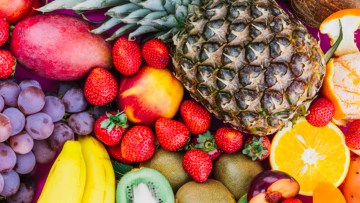Fruit
A Tasty Basis for a Healthy Life
"An apple a day keeps the doctor away"-- the old British saying emphasizes in simple terms the wholesome effects of the apple. This is because vitamin and mineral-rich fruit is good for the human body. Fortunately, according to the Deutschen Gesellschaft für Ernährung (German Society for Nutrition), it may be a bit more than that. Nutritionists recommend eating two portions of fruit daily. No other country in the European Union consumes as many apples as Germany does on an annual basis--an entire 26 kilos (over 57 pounds) per capita. Though the "king of the apples" among the over local 2,000 varieties is the Elstar.
Furthermore, fruit is regarded as more than just a slimming agent. People with excess weight especially should make food with lower energy density--which includes the majority of fruit varieties--the basis of their daily diet. As a result, one gets full even with a comparatively lower energy intake. By the way, people who eat lots of fruit are less likely to fall ill from cardiovascular diseases, high blood pressure and strokes.
How is fruit cultivated?
Commercial fruit-growing has little in common with the cultivation of private gardens. The modern apple farmer doesn't go with a big ladder from tree to tree. Aside from a small market niche for standard-tree orchards, half-standard tree grounds are predominant among fruit-growing trees. The growth height for the trees on these grounds is so restricted that all the fruit can be picked by hand without a ladder.
In the case of strawberry cultivation, so-called high tunnels are gaining in importance. These are mobile greenhouses with a width of five to ten meters (approximately 16 to 33 feet) and a height of about 2.5 meters (approximately 8 feet). With tunnel cultivation, the first strawberries can be harvested up to a month earlier than they would be via open land cultivation. In the case of berry fruit, soilless cultivation is gaining in importance. During this process, the greenhouse plants are cultivated in nutrient solutions or sand rather than soil. The advantage: The nutrient supply can be measured out more precisely than with soil-based cultivation. Disease infestation is also generally lower with soilless cultivation.
Contribution to Sustainability
Consumers who purchase locally-grown seasonal fruit contribute to sustainability. Because there is no accumulation of long transports, the result is an improved energy footprint. Locally-produced fruit offers additional benefits. Because it is harvested when it has achieved an ideal ripeness, it contains the highest amount of vitamins and has a more intense flavor. Seasonal and local – clearly a good choice.
Challenges in the Cultivation of Fruit
Time and again, late frost leads to the severe decimation of fruit harvests. In spite of the protective measures taken by growers, the flower primordiums of nearly all fruit species were so heavily destroyed by night frosts in the year 2017 that no fructification took place. Further losses were caused by erratic weather conditions and regional heavy rains, or even occurrences of hail.
Pest insect control poses a challenge as well. While addressing it, it is important to establish a balance between the protection of beneficial organisms, and the effective control of relevant pests.
For the effective control of scab and mildew--the most significant pathogens with respect to apple cultivation--selective spraying is necessary. So that the apples remain healthy while in storage, storage diseases must also be reliably controlled even before the harvest.
Diseases in Fruit
BASF's Contribution
- Qualitative pesticides for high-quality fruit
- Effective control of relevant disease symptoms in stone and pome fruit
- Growth regulators for fertile fruit-growing
- High-performance control of scab, mildew, apple codling moths and all other typical fruit diseases.
- Optimized co-crystal formulation with the agents dithianon and pyrimethanil


